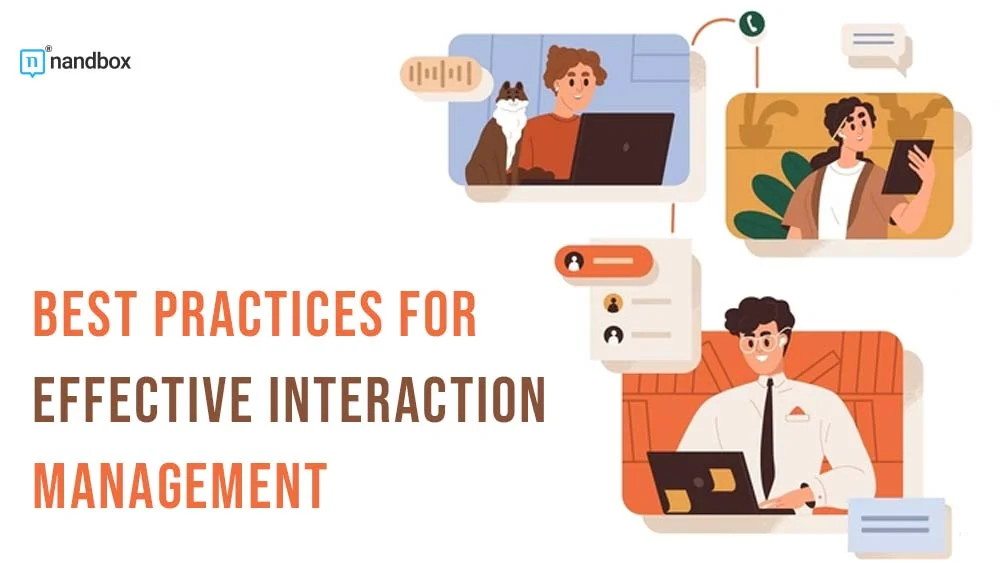Boosting Customer Engagement: Best Practices for Effective Interaction Management
In today’s fast-paced digital world, customer engagement has become more crucial than ever. Businesses across industries are constantly seeking effective strategies to interact with their customers and build long-lasting relationships. By employing best practices in interaction management, businesses can boost customer engagement. Additionally, cultivate brand loyalty. From personalized communication to seamless omnichannel experiences, this article dives deep into the proven techniques that drive meaningful interactions.
We will explore the importance of active listening, empathy, and timely responses in creating a positive customer experience. I know that these sound obvious, but bear with me. We will discuss the power of data-driven insights in understanding customer preferences and tailoring interactions accordingly. Whether you are a small startup or an established enterprise, implementing these best practices will not only enhance customer satisfaction but also drive revenue growth. Join us as we uncover the secrets to successful customer engagement and discover how your business can thrive in the age of digital connectivity.
The Importance of Customer Engagement
Customer engagement is one of the most crucial factors in having a successful strategy for effective interaction management. This factor is what will help businesses truly thrive in today’s digital era. Most people would simply refer to customer engagement as a simple matter of communication between customers and the businesses they’re signing up for. However, we have a whole different, or maybe a much more detailed, definition of customer engagement.
So, what is customer engagement? Customer engagement refers to the ongoing interaction between a brand or business in general and its customers. This encompasses all touchpoints and interactions throughout the customer journey.
The whole process goes beyond simply acquiring new customers. It involves building strong relationships and fostering loyalty. Engaged customers are more likely to benefit you in multiple ways. For example, Make repeat purchases, refer others to the brand, and become brand advocates. They are also more forgiving when issues arise, as they feel a connection with the brand. In contrast, disengaged customers are more likely to churn and take their business elsewhere. Therefore, investing in customer engagement is not just a nice-to-have; it is essential for long-term success. Effective customer engagement starts with understanding the needs, preferences, and pain points of your target audience.
Customer Engagement: How To Meet Their Expectations
By gaining insights into their motivations and desires, you can tailor your interactions and offerings to meet their expectations. This requires a deep understanding of your customer base, which can be achieved through data analysis, customer surveys, and feedback collection. Once you have a clear understanding of your customers, you can design interaction management strategies that resonate with them and create meaningful connections.
Understanding Interaction Management
Interaction management refers to the practices, processes, and systems businesses use to handle customer interactions across various channels. It involves managing both inbound and outbound interactions, ensuring that each touchpoint is handled effectively and consistently.
Effective interaction management requires a proactive approach. One where businesses actively seek opportunities to engage with customers rather than simply reacting to their inquiries or complaints. It involves creating seamless experiences across channels, from social media and email to phone calls and in-person interactions. In other words, monotonic tones won’t be of great help to your interaction management strategy.
To effectively manage interactions, businesses must have a clear understanding of their customers journeys. Mapping out the customer journey helps identify key touchpoints and potential pain points. This allows businesses to proactively address customer needs and concerns. By aligning their interactions with the customer journey, businesses can deliver a consistent and personalized experience at every stage. Which helps them foster stronger connections and improve customer satisfaction.
The Benefits You Gain From Effective Interaction Manag ement
Of course, we have a paragraph for you related to how this topic will benefit your business.
Firstly, by actively listening to customers, empathizing with their concerns, and providing timely and helpful responses, businesses can enhance the overall customer experience. Remember, we humans thrive on communication. Furthermore, if your business is one that doesn’t have employees who have enough patience and sympathy, I hate to be the one to break it to you, but it simply won’t succeed.
Secondly, effective interaction management strengthens brand loyalty. When customers feel valued and heard, they develop a sense of loyalty towards the brand. They are more likely to choose the brand over competitors, even if it means paying a premium. By consistently delivering exceptional interactions, businesses can differentiate themselves from competitors and build a loyal customer base.
Thirdly, effective interaction management drives revenue growth. Engaged customers are more likely to make repeat purchases and spend more with the brand. They are also more likely to recommend the brand to others, leading to increased customer acquisition. By optimizing interactions to drive customer engagement, businesses can boost their bottom line and drive sustainable growth.
What Elements Should You Have for an Effective Interaction Management Strategy?
Customer engagement requires effective interaction management. Interaction management simply starts with active listening. It requires listening to customer issues, inquiries, and feedback. Additionally, respond with empathy when you’re addressing them.
Businesses can gain insights and meet client demands by listening. Active listening fosters empathy. It requires imagining the customer’s feelings and frustrations. I know how much we’re focusing on empathy and mentioning it a lot; however, it really helps organizations build better client relationships.
Interaction management requires prompt reactions. Customers want answers quickly. Businesses earn trust by responding quickly. Meaningful relationships require personalization. Customers like customized experiences. Businesses can personalize consumer encounters by using customer data and insights. Trust and loyalty require consistency. Customers demand consistency across all touchpoints. Consistent encounters help organizations build brand identification and client loyalty.
7 Proven Strategies For Boosting Customer Engagement
- Segmentation and Targeting: By segmenting your customer base and targeting specific groups with tailored interactions, you can deliver more relevant and personalized experiences. This can be achieved through data analysis and customer profiling.
- Proactive Outreach: Don’t wait for customers to reach out to you; take the initiative to proactively engage with them. This can be done through personalized emails, social media interactions, or even phone calls. By reaching out, you show customers that you value their business and are committed to their satisfaction.
- Omnichannel Experience: Create a seamless experience across all channels, allowing customers to interact with your brand through their preferred channels. Ensure that customer data is shared across channels, enabling a consistent and personalized experience.
- Social Listening: Monitor social media platforms and online forums to listen to customer conversations about your brand. By actively engaging in these conversations and addressing customer concerns, you can demonstrate your commitment to customer satisfaction and build positive brand sentiment.
- Proactive Issue Resolution: Anticipate and address customer issues before they become major problems. By proactively reaching out to customers who may be experiencing difficulties, you can prevent negative experiences and turn them into positive ones.
- Customer Feedback and Surveys: Collect feedback from customers to understand their satisfaction levels and identify areas for improvement. Use this feedback to continuously enhance your interaction management strategies and deliver exceptional experiences. This is also a great opportunity to identify customer references.
- Personalized Recommendations: Leverage customer data to provide personalized recommendations and offers based on their preferences and past interactions. By showing customers that you understand their needs and can anticipate their desires, you can foster deeper connections and drive engagement.
The Best Practices That You Can Implement to for Handling Customer Interactions
To effectively handle customer interactions, businesses should follow these best practices:
- Respond Promptly: Aim to respond to customer inquiries or issues within a reasonable timeframe. Set clear response time goals and ensure that your team is equipped to meet them.
- Be Knowledgeable: Ensure that your customer service representatives are well-trained and knowledgeable about your products or services.
- Use Positive language. Choose your words carefully when interacting with customers. Use positive and empathetic language to show that you understand their concerns and are committed to finding a solution.
- Take Ownership: When a customer has an issue, take ownership of the problem and work towards a resolution. Avoid passing the blame or making excuses.
- Empower Your Team: Provide your team with the authority and resources they need to handle customer interactions effectively. Empower them to make decisions and resolve issues independently, whenever possible. This will reduce customer frustration and lead to faster resolutions.
- Follow-Up: After resolving a problem, check in with the customer to make sure they are happy. This shows that you value their feedback and are committed to their ongoing happiness.
Wrapping It Up!
The future of customer engagement and interaction management holds great potential. It is what will help businesses thrive and become the most successful versions of their futuristic vision. By implementing these best practices and continuously measuring and improving performance, businesses can unlock the true power of customer engagement and secure their place in a competitive marketplace. Embrace the future of customer engagement, and watch your business soar to new heights.
Another solution that can help your business thrive is creating an app for it. If you implement the right customer engagement and interaction management strategies, your app will take you to a whole new level of success. With nandbox’s native no-code app builder, you will develop an app in the blink of an eye. Sign up now, and don’t miss the opportunity to grasp success in your hands.







